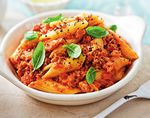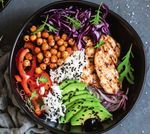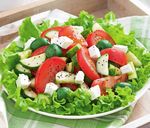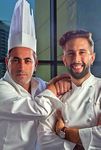A WAY OF MEDITERRANEAN - IICUAE
←
→
Page content transcription
If your browser does not render page correctly, please read the page content below
THE
MEDITERRANEAN
DIET
A WAY OF
LIVING
FOOD THAT IS SIMPLE YET SUMPTUOUS,
LIGHT YET FILLING, VIBRANT AND ALL-NATURAL
T
he Mediterranean diet first became high intake of plant-based foods (fresh
of interest to researchers in the fruit and vegetables, nuts, and cereals)
1950s when certain populations in and olive oil, a moderate intake of fish and
the Mediterranean Sea basin were poultry, and low intake of dairy products
observed to be healthier than wealthier (mostly yoghurt and cheese), red and
nations of the developed world. Therefore, processed meats, and sweets.
the diet refers to the traditional food
cultures of the countries that surround By taking the Mediterranean diet and
the Mediterranean Sea, including Greece, making some changes we find the so-
Italy and Spain. The Mediterranean diet called Italian diet, officially developed and
primarily consists of a plant-based eating recognised in 2003. Italy, which is fortunate
pattern, which comes with many health to be a country in the world with one of the
benefits, including protection against greatest biodiversities, can intervene in the
cardiovascular and metabolic disorders and Mediterranean diet, ensuring a huge variety
cognitive deficits. and structural changes, such as the balance
between carbohydrates and proteins, while
However, the Mediterranean diet simultaneously assigning an important role
encompasses more than just food; it is to complex carbohydrates (barley, oats,
in fact often described as a way of living millet, semolina, beans and lentils), marking
rather than just a ‘diet’. People living in at the same time the need to avoid added
the regions where the diet originated tend sugars and certain beverages or to consume
to enjoy a lifestyle that values nutritious them in extreme moderation.
food along with physical activity, social
gatherings and relaxation — all of which The Italian diet, whose main purpose is
can positively influence health. to defeat obesity, supports the cuisine
that seeks the right compromise between
The diet is generally characterised by a palatability, satiety and low-calorie content,
26 R AMADAN COOKBOOK | KHALEE J TIMESMAURO MARZOCCHI
Secretary General
Italian Industry and Commerce Office
in the UAE
What makes the Mediterranean diet so popular?
First of all, the Mediterranean diet is structured on the
following key points: a greater diversified and balanced
consumption of plant-based foods compared to animal
ones, the reduction of saturated fats in favour of
unsaturated vegetables, reduction of the caloric quota,
increase of carbohydrates, introduction of high fibre,
all using mainly local products with a Denomination of Controlled greater consumption of white meat, fish and legumes and
Origin (DOC) or having the Protected Designation of Origin (PDO) occasional consumption of sweets. The Mediterranean diet
label. This type of food culture could be extremely useful for all has been therefore declared a ‘world heritage’, precisely
those who are shortly preparing for the month of Ramadan, a period because it is the type of diet and lifestyle that is at the base
of fasting and purification in which Muslims are encouraged to of the well-being of the population, making it so popular.
practise self-control from the dawn prayer (Suhoor) to the sunset Extensive and significant research has also highlighted
prayer (Maghrib). that the Mediterranean diet can reduce the incidence of
cardiovascular diseases, tumours and other serious diseases.
During Ramadan, overeating could be very dangerous for health. To Last but not the least, when it comes to the Mediterranean
meet the amount of energy and nutrients the body needs during the diet attention to the quality and quantity of foods must
day, it is recommended to eat foods rich in protein, carbohydrates, always be paid.
vitamins, and minerals, together with drinking enough water. The diet
should therefore be simple, characterised by the presence of complex Let’s compare Islamic Ramadan and Christian Easter in terms
carbohydrates, useful for the slow release of energy during the long of eating habits, can you spot any similarities?
hours of fasting, of fibres, which interfere with the absorption of lipids Lent reflects the 40 days Jesus was said to have spent
(fatty acids and cholesterol) and carbohydrates (i.e. sugars), resulting fasting in the wilderness, and Christians honour this by
in a valuable ally in the fight against obesity and diseases supported by abstaining from certain things. Lent and Ramadan do share
the lack of control of blood sugar and cholesterol. many similarities. Both Ramadan for Muslims and Easter for
Christians, are periods of time where more attention must be
Foods to avoid on the other hand are simple or refined paid to the way we feed ourselves compared to the rest of the
carbohydrates like sugars, white flour, pastries, doughnuts and year. While for Christians the only meal allowed can be made
croissants since they last only three to four hours and are low in during the day, for Muslims who can eat and drink only after
essential nutrients; salty foods since they will cause the imbalance sunset, more attention to quality and quantity of food must
of sodium levels in the body making you thirsty; caffeinated drinks, be paid. However, while fasting, Muslims abstain from eating
which will lead to insomnia and restlessness; carbonated drinks and or drinking from sunrise to sunset, for Christians the law of
fried foods. fasting asks to make a single meal during the day, following
the approved religious traditions for quantity and quality.
Christians avoid eating meat and sophisticated foods in the
forty days of diet imposed by Lent before Easter.
Both periods refer to the respective revelations: for
Christians, the beginning of the public life of Jesus, which
will bring fulfilment to Salvation, for Muslims, the beginning
of the revelation of Allah’s will to the Prophet Muhammad.
Consequently, both Ramadan and Lent are periods of penance
to get closer to God. For Muslims and Christians, penance
in periods such as Ramadan and Lent is a religious, personal
act, which has its goal in the love and abandonment to God:
fasting for it, not for oneself. In both religions, abstinence
must be observed along with some other penances, as well
as prayer and charity activities. Another similarity between
both Ramadan and Lent is the fact that they end in a joyous
festival. Ramadan concludes with the festival of fast-
breaking, Eid ul-Fitr. Lent ends with Easter, the festival of the
Resurrection, which celebrates new life in Christ.
What is your final consideration?
In the end, food, together with prayer and charitable acts,
brings people together regardless of religious beliefs.
KHALEE J TIMES | R AMADAN COOKBOOK 27ROYAL PIZZA
CHEF & OWNER
DOMENICO STRANIERI
Pulcinella
INGREDIENTS METHOD
1.6 kg flour 60 gm tomato sauce Sprinkle the yeast into a bowl with warm water, place 80% of the flour inside,
1 L water 50 gm cherry tomatoes mix everything with the salt, sugar, the rest of the flour and the oil.
100 gm beef bresaola 30 gm rocket leaves Knead everything together for 10 minutes until the dough is smooth and elastic.
2 gm yeast 80 gm stracciatella cheese Create a bowl, cover it and let it rest of 8 to 10 hours.
50 gm salt Basil leaves Remove the dough from the bowl on a floured surface and create the pizza pan.
20 gm sugar Add tomato sauce, and bake it in the oven at 250°C for 10 minutes, then add
10 gm extra virgin olive oil the rocket leaves, beef bresaola, cherry tomatoes, stracciatella cheese, basil and
280 gm dough extra virgin olive oil.
KHALEE J TIMES | R AMADAN COOKBOOK 37CONFIT LAMB
WITH PILAF
CHEF
ALESSANDRO MICELI
HEAD CHEF NICHOLAS REINA
Bella Restaurant & Lounge
Grand Millennium Hotel
INGREDIENTS
LAMB
3 kg whole lamb leg RICE
8 L sunflower oil (to confit) 320 gm carnaroli rice METHOD
15 gm coffee beans 700 gm chicken stock
20 gm green cardamom 1 gm saffron Roast all the spices in the sunflower oil.
20 gm black cardamom 50 gm raisins Cover the dish with aluminium foil and
20 gm star anise 60 gm pistachio cook for 9 hours at 95°C in the oven.
20 gm cinnamon stick 50 gm almond flakes Roast the nuts, mix all the ingredients
20 gm black peppercorn 100 gm capsicum and pour everything in a pot, cook in the
20 gm rosemary 50 ml extra virgin olive oil oven at 145°C for 30 to 40 minutes.
20 gm thyme Salt to taste Place the rice and put the lamb meat on
20 gm tarragon 10 gm parsley top and chopped parsley to garnish.
40 R AMADAN COOKBOOK | KHALEE J TIMESYou can also read



























































